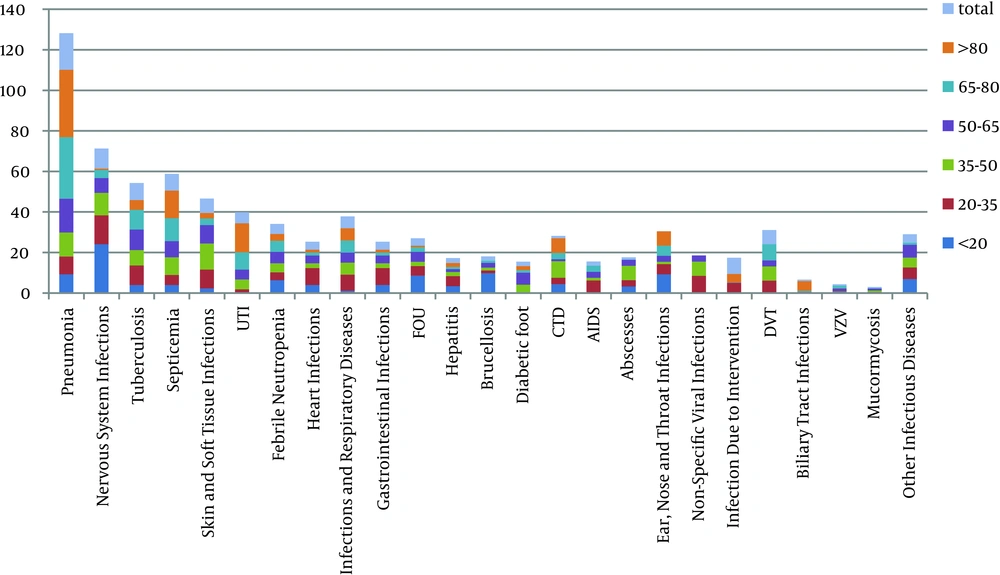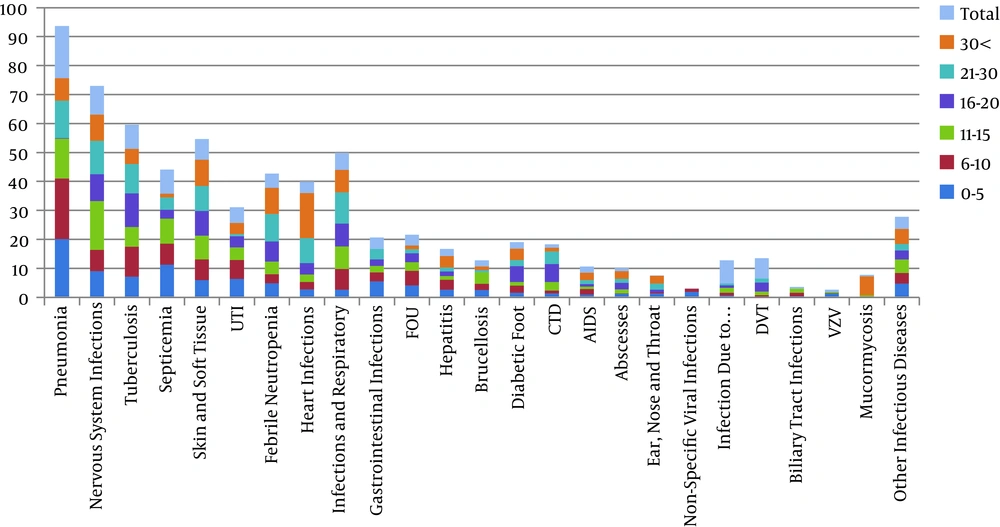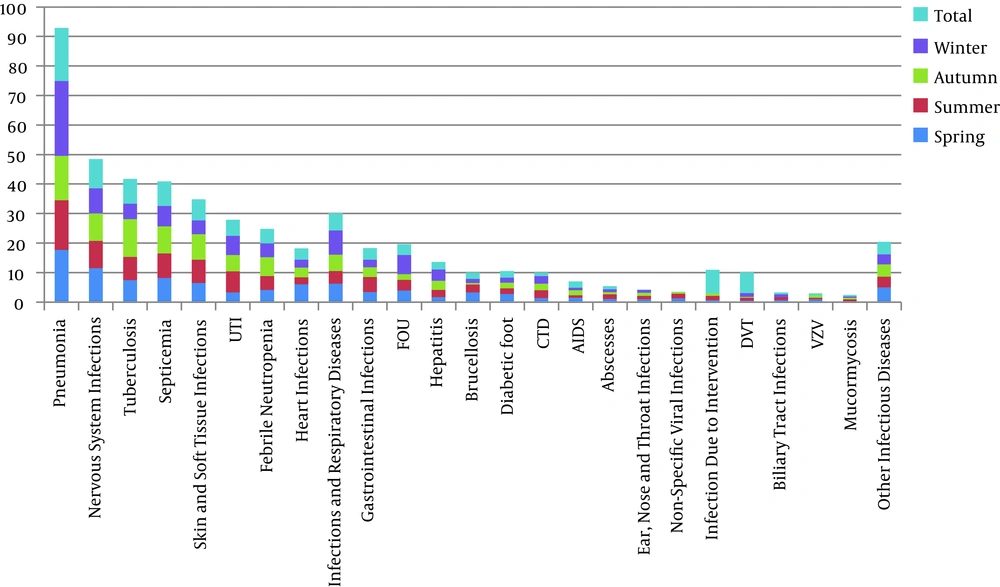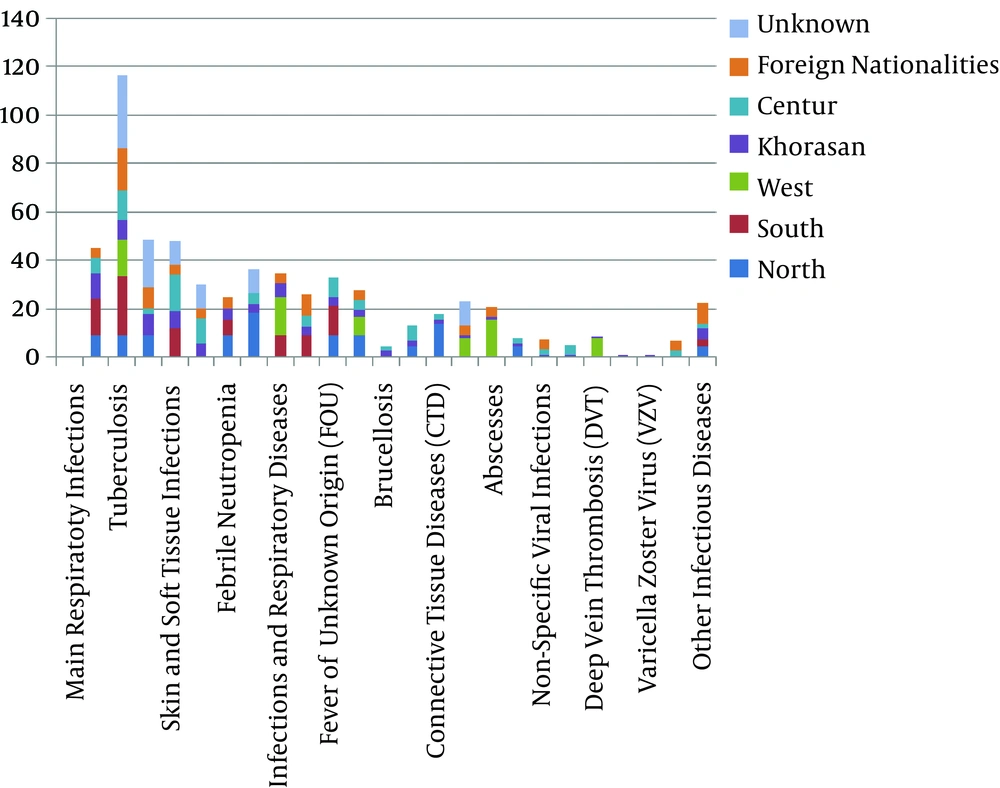1. Background
Despite recent advancements in the treatment and prevention of infections, infectious diseases are still one of the leading causes of mortality and morbidity worldwide (1). In general, infectious diseases are categorized into two types of transmissible and communicable (2).
Presence and growth of pathogenic and biological agents in human host organisms are the main factors associated with the incidence of infectious diseases (2). In other words, infections are directly resulted from disease-causing agents that invade the body tissues of the host organism. This process is followed by the reaction of host tissues to disease-causing agents and the produced toxins (3); infectious agents, microorganisms, nematodes and fungi are other eminent causes of infectious diseases (4).
Recent medical advancements contributed to the treatment of several diseases and reduction of mortality and morbidity rates (4, 5). However, despite the progressive production of antimicrobial agents, antibiotic resistance is growing at an alarming rate in mammals (4, 5). Some examples are penicillin-resistant pneumonia and vancomycin-resistant Enterococcus (VRE). These pathogens could cause major clinical problems and complicate the management of the infections that could be easily treated. According to some resources, environmental changes could also lead to the occurrence of infectious diseases (4, 5).
The importance of epidemiological studies to recognize and manage infectious diseases was first highlighted in medicine. Epidemiological study of infectious diseases is crucial to maintain public health, prevention of mortality and morbidity, and developing cost-efficient methods of disease control. Furthermore, epidemiological studies could investigate the patterns, causes and effects associated with normal and diseased conditions in specific populations (5).
The primary areas assessed in epidemiological studies are disease etiology, disease transmission, disease surveillance and screening, biomonitoring, comparison of the effects of different treatments and evaluation of disease prevalence (5).
Several recent studies assessed the rate of infectious diseases in various countries (6-8). In addition, some studies were performed to evaluate the rate of some infectious diseases in Iran. For instance, a study by Hatami et al. (9) was conducted in Kermanshah, Iran, to assess the laboratory and epidemiologic features of urinary tract infections (UTIs) in elderly patients, which indicated that the most significant causes of hospitalization in patients with infectious diseases were respiratory infections, gastroenteritis and sepsis (10). Moreover, another epidemiological research by Metanat et al. was performed to evaluate the rate of extra-pulmonary tuberculosis in Zahedan, Iran (11).
The rate of infectious diseases is high in Khorasan province, Iran, and various factors are involved in the epidemiology of such diseases (12, 13).
2. Objectives
The current study aimed to determine the epidemiology of different infections in patients admitted at the infectious dease ward of Imam Reza hospital from 2006 to 2008 in Mashhad, Iran.
3. Methods
This cross-sectional study was conducted on all the patients referring to the infectious disease ward of Imam Reza hospital in Mashhad, Iran during 2006 - 2008 (number of patients = 1,681). The sampling frame included all admissions for patients over 18 years old. No Inclusion and exclusion criteria for the practices were defined and the need for informed consent for this study was waived. Infection was diagnosed and detected based on history and physical examination and laboratory tests for each patient by infectious disease specialists.
In the study, demographic data were not available for some of the patients; nevertheless, these patients were not excluded from the study.
Prepared checklists were used to collect the required clinical data of patients, including age, gender, employment status, place of residence, length of hospital stay and season of admission. In addition, demographic data were obtained from the medical records of the patients. Medical history of the patients remained confidential during the study, and any disclosures of financial or non-financial conflicts were respected.
Data analysis was performed using tables, graphs and statistical tests by SPSS ver. 16 and Microsoft Excel software.
4. Results
In total, 1,681 patients referring to the infectious disease ward of Imam Reza hospital were enrolled into the study. The frequency of the age of subjects is shown in Figure 1. Comparison of the prevalence of infectious diseases based on the age of the patients is shown in Figure 2.
In total, 61.3% and 38.7% of the patients were male and female, respectively. Major respiratory (e.g. pneumonia) and nervous system infections were observed in 18% (n = 302) and 9.9% (n = 167) of the patients, respectively.
In the study, prevalence of tuberculosis, septicemia, skin and soft tissue infections, urinary tract infections, febrile neutropenia, myocarditis and gastrointestinal infections were estimated 8.4% (n = 141), 8.3% (n = 139), 7.1% (n = 120), 5.4% (n = 90), 4.9% (n = 82), 3.9% (n = 65) and 3.8% (n = 64), respectively. Also, major respiratory infections were reported in 5.8% (n = 97) of the studied patients.
Among the female patients in the study, 20.9% (n = 136) and 10.56% (n = 68) were diagnosed with pneumonia and tuberculosis, respectively. Moreover, 8.8% (n = 57), 8.6% (n = 56), 6.3% (n = 41), 4.3% (n = 28), 4.3% (n = 28), 2.2% (n = 14) and 4.6% of female patients had nervous system infections, septicemia, skin and soft tissue infections, febrile neutropenia, UTI, myocarditis and gastrointestinal infections, respectively. Other types of respiratory infections were reported in 4.3% (n = 28) of female patients.
As for the male patients, 16.1% (n = 166) and 10.7% (n = 110) were diagnosed with pneumonia and nervous system infections, respectively. In addition, tuberculosis, septicemia, skin and soft tissue infections, UTI, febrile neutropenia, myocarditis and gastrointestinal infections were reported in 7.1% (n = 73), 8.1% (n = 83), 7.7% (n = 79), 4.8% (n = 49), 5.2% (n = 54), 4.9% (n = 51) and 3.3%, respectively. Also, other respiratory infections were observed in 6.7% (n = 69) of the male patients in the study.
With regard to the length of hospital stay, 41% of the patients were hospitalized for less than five days, while 24.7%, 13.8%, 7.7% and 8.2% were hospitalized for 5 - 10, 11 - 15, 16-20, and 21 - 30 days, respectively. Moreover, 4.6% of the patients were hospitalized for more than 30 days.
According to the study findings, 34.7%, 30.2%, 21.4% and 13.8% were admitted during the spring, summer, autumn and winter, respectively. Additionally, 91% of the studied patients were residents of Khorasan province and 2.9%, 2%, 1.4%, and 0.8% lived in the center, South, North and West of the region, respectively. It is noteworthy that 1.4% of the patients in this study were from other countries and 0.6% had unknown origins.
Prevalence rates of infectious diseases in terms of the length of hospital stay, season of admission, and place of residence are presented in Figures 3, 4 and 5.
With respect to employment status, 57.8% and 28.89% of the patients were unemployed and self-employed; while 7.3%, 3.8%, 0.7%, 0.3% and 0.2% were state employees, shepherds or farmers, unemployed, military members and physicians, respectively. In addition, 1.1% of the studied patients were prisoners.
Prevalence of major respiratory infections (e.g. pneumonia), nervous system infections, tuberculosis and hepatitis in terms of the length of hospital stay and age of the patients are shown in Table 1 and Figure 2.
| Length of Hospital Stay, days | |||||||
|---|---|---|---|---|---|---|---|
| Infectious Diseases | 0 - 5 | 6 - 10 | 11 - 15 | 16 - 20 | 21 - 30 | 30 < | |
| Major respiratory infection, pneumonia | Bacterial pneumonia | 46.0 | 28.2 | 10.8 | 7.0 | 5.9 | 2.1 |
| Viral pneumonia | 66.7 | 0.0 | 0.0 | 0.0 | 33.3 | 0.0 | |
| Aspiration pneumonia | 41.7 | 50.0 | 8.3 | 0.0 | 0.0 | 0.0 | |
| Nervous system infections | Bacterial meningitis | 3.2 | 16.1 | 51.6 | 12.9 | 9.7 | 6.5 |
| Tuberculous meningitis | 32.0 | 24.0 | 28.0 | 4.0 | 8.0 | 4.0 | |
| Viral meningitis | 56.5 | 19.4 | 14.5 | 3.2 | 4.8 | 1.6 | |
| Encephalitis and meningitis | 38.3 | 17.0 | 14.9 | 10.6 | 14.9 | 4.3 | |
| Cerebral venous sinus thrombosis | 0.0 | 0.0 | 0.0 | 0.0 | 50.0 | 50.0 | |
| Tuberculosis | Respiratory tuberculosis | 36.6 | 30.9 | 12.2 | 9.8 | 7.3 | 3.3 |
| Tuberculosis infection of other organs | 22.2 | 27.8 | 5.6 | 16.7 | 27.8 | 0.0 | |
| Infections and respiratory diseases | Pulmonary embolism | 0.0 | 46.7 | 13.3 | 20.0 | 20.0 | 0.0 |
| Empyema | 17.9 | 10.7 | 21.4 | 7.1 | 28.6 | 14.3 | |
| Pleural effusion | 20.8 | 33.3 | 25.0 | 4.2 | 12.5 | 4.2 | |
| COPD | 26.7 | 40.0 | 13.3 | 20.0 | 0.0 | 0.0 | |
| Bronchiectasis | 0.0 | 100.0 | 0.0 | 0.0 | 0.0 | 0.0 | |
| Acute respiratory distress syndrome | 50.0 | 16.7 | 16.7 | 16.7 | 0.0 | 0.0 | |
| Pneumothorax | 25.0 | 0.0 | 25.0 | 0.0 | 25.0 | 25.0 | |
| Hepatitis | Hepatitis B | 28.6 | 42.9 | 14.3 | 0.0 | 14.3 | 0.0 |
| Hepatitis C | 60.0 | 40.0 | 0.0 | 0.0 | 0.0 | 0.0 | |
| Cytomegalovirus-induced hepatitis | 100.0 | 0.0 | 0.0 | 0.0 | 0.0 | 0.0 | |
| Non-viral hepatitis | 37.5 | 33.3 | 4.2 | 8.3 | 4.2 | 12.5 | |
| Chronic hepatitis B | 75.0 | 25.0 | 0.0 | 0.0 | 0.0 | 0.0 | |
| Hepatic peliosis | 0.0 | 0.0 | 100.0 | 0.0 | 0.0 | 0.0 | |
Frequency of Major Infectious Diseases Based on Length of Hospital Stay at Imam Reza Hospital
According to the information in these tables, the majority of the patients diagnosed with pneumonia were within the age range of 65 - 80 years, and a few cases were less than 20 years. Moreover, the majority of the patients diagnosed with nervous system infections were within the age range of 20 - 35 years, and a few cases were above 80 years.
Investigation of the prevalence of nervous system infections revealed that 96.8%, 88%, 96.8%, and 89.4% of the studied patients had bacterial meningitis, tuberculous meningitis, viral meningitis, encephalitis and meningitis, respectively. All these patients were residents of Khorasan province. It is also noteworthy that none of the studied patients who lived in Khorasan province were diagnosed with cerebral venous sinus thrombosis (CVST).
With regard to the season of admission, 21.1%, 40%, 22.21%, and 16.7% of the studied patients with UTI were admitted during the spring, summer, autumn and winter, respectively. In addition, 51.4%, 35.1%, 4.4%, and 8.1% of the patients with brucellosis were admitted during the spring, summer, autumn and winter, respectively.
5. Discussion
According to the results of the current study, the most common causes of hospitalization among the patients with infectious diseases were major respiratory infections (e.g. pneumonia), nervous system infections and tuberculosis. In another study performed by Hatami et al. in Kermanshah, Iran, the most significant causes of hospitalization in patients with infectious diseases were respiratory infections, gastroenteritis and sepsis (9). This difference could be due to geographical variations, since Kermanshah is located in the West of Iran, while the current study was conducted in the North-Eastern part of the country.
According to the findings of Robinson et al., incidence of pneumonia was estimated at 23.2 cases per 100,000 people, which was higher than the results of the present study. Furthermore, pneumonia was reported most prevalent among young children and adults aged above 65 years (14). This finding was confirmed by Rudan et al. (15).
With respect to nervous system infections, the prevalence was higher in the current research compared to similar studies (16, 17); this difference could be attributed to geographical variations.
According to the results of the current study, the highest incidence rate of tuberculosis was observed in patients within the age range of 65-80 years, which was significantly higher compared to the rates reported in Nigeria and China (18). In the report published by the institute of Iranian studies in 1982 (11), the incidence rate of tuberculosis was 22.5%, while it was lower in the current study. In general, the prevalence of tuberculosis was lower in the present study compared to similar studies in this regard (11). This difference could be due to the implementation of directly observed therapy short-course (DOTS) program to monitor tuberculosis, recently established in Iran.
According to the results of the current study, prevalence of tuberculosis of other organs was equally observed in both genders; while the results obtained by Metanat et al. indicated that the prevalence of extra-pulmonary tuberculosis was higher among female patients in Zahedan, Iran (11). This difference could be due to geographical variations, as well as the lack of sufficient healthcare facilities in Zahedan. With regard to the prevalence of tuberculosis of other organs, the findings of Metanat et al. at the institute of Iranian studies were inconsistent with the results of the present study (11).
According to the current study findings, the highest incidence rate for tuberculosis of other organs was reported in the southern part of Khorasan region, while the lowest rate was reported in the North-Western part of the province.
According to the study by Metanat et al., (11) tuberculosis of other organs was more prevalent among foreigners. This could be due to the larger population of other nationalities, especially Pakistanis and Afghans, in Zahedan. In another research by Moradi et al., the incidence rate of extra-pulmonary tuberculosis was higher compared to the results of the current study (19).
According to the results of the present study, prevalence of UTI was similar in both genders, whereas the findings of Hatami et al. indicated more prevalent of UTI among female patients (20). Furthermore, patients diagnosed with UTI were older in the current research compared to those of the study by Hatami et al. This difference could be due to geographical diversities, intervals between the studies and general improvement of health conditions in Khorasan region.
According to the current study findings, nearly half of the patients diagnosed with infectious diseases were admitted during the summer, and the lowest number of admissions was reported in the winter. This finding was in line with the results obtained by Hatami et al. (20), and differences in the season of admission could be due to factors such as dehydration and decreased urine volume during warm seasons.
The study findings were indicative of the higher prevalence of infective endocarditis (IE) among male patients, which was consistent with the results obtained by Tleyjeh et al. (21). Moreover, the majority of the patients diagnosed with myocarditis were within the age range of 20 - 30 years in the current study, and only a few cases were above 80 years. It is noteworthy that the mean age of patients with IE was significantly higher in the study by Tleyjeh et al. (21), compared to that of the present study.
The prevalence of hepatitis in the present research was similar to the rates reported by similar studies in Iran (22-25). However, the incidence rates were reported lower in the neighboring countries of Iran (26) and Northern Europe (2), while they were higher in different parts of Egypt.
In general, the incidence rate of hepatitis was very low in the current study. According to another research this rate might vary from 0.1% to 20% in different countries worldwide. The prevalence of hepatitis in the present study was significantly lower compared to those of the similar studies (26-28).
In the present study, hepatitis was more prevalent among male patients, which was similar to the findings of Yeoh (29). Furthermore, the majority of the patients diagnosed with hepatitis B were within the age range of 20 - 35 years, which was similar to the findings of the study by Farhat et al. (13).
As for brucellosis, the male-to-female ratio in the present study was similar to those of the latest findings. The majority of patients with brucellosis in the current study were less than 80 years, and the incidence rate of this infection was reported higher compared to that of the current study.
In the current study, almost half of the patients diagnosed with brucellosis were admitted during the spring, while in another study the majority of such patients were admitted during the summer and spring.
5.1. Conclusion
According to the results of the study, major respiratory infections (e.g. pneumonia), nervous system infections, tuberculosis, septicemia, skin and soft tissue infections, and UTI were the most common causes of hospitalization. Given the diversity of infectious diseases, epidemiological studies are required to determine the incidence rates of different infections, especially in regions with high prevalence. Also, etiological diagnosis of infectious diseases is considered imperative for clinicians before initiating the therapy.
One of the limitations of the present study was that demographic data were not available for some of the patients; nevertheless, these patients were not excluded from the study. Furthermore, detailed statistical analysis of all infectious diseases was not possible due to the immense variety of infections. Pneumonia is associated with a very high mortality rate, therefore, it is recommended to conduct further studies on the etiology and treatment of this infectious disease. Moreover, further epidemiological studies are required to compare the incidence rates of infectious diseases in different regions of Iran.




